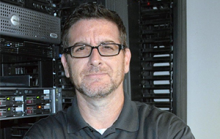When Sonic Automotive set out to transform the car-buying experience, the company’s IT organization stepped out from behind the curtain to take a leading role. Leaders at the automotive dealership wanted to take the car-shopping experience to the next level by putting an emphasis on customer experience using innovative technology. That strategic decision helped give Sonic’s IT organization its big break.

“With a mindset to disrupt the automotive retail industry by focusing on the customer experience, the business relied on IT to lead the transformation,” said Chris Maritato, vice president of business technology at Sonic Automotive, one of the largest automotive retailers in the United States.
Maritato was recently recognized for his leadership efforts with the Enterprise CIO of the Year award from the Charlotte CIO Leadership Association. We asked him to talk about the role technology played in Sonic’s transformation and the efforts his team put into truly understanding customer needs.
The Enterprisers Project (TEP): IT leaders are increasingly tasked with projects that make money rather than save money. How has this shift in mandate impacted the evolution of your own career and your role as CIO of Sonic Automotive?

Chris Maritato: Technology in our organization is now seen as a competitive advantage. Historically, that hasn't been the case at Sonic; it was a necessary expense. Sonic trusts the technology team and our partners to deliver innovative solutions with the business. As a result, my career has shifted to more of an entrepreneurial focus, where I’m now seeking out opportunities for our future and asking the right questions to draw out the best in all of us to meet business expectations.
One way our technology team is working to contribute to Sonic’s money-making efforts is through the reporting tools we’ve incorporated into our applications. We build our applications using the knowledge captured in our playbook. This enables a predictable, repeatable, and sustainable process that is measured and should be followed on a consistent basis. We now have the ability to track when an associate deviates from the process, which allows us to hold them accountable. The end result is that it fosters transparency and builds a trusted brand with our customers because it allows us to deliver the best experience.
For example, in Fixed Operations, we’ve built reporting to measure how often our service advisors follow our processes when interacting with our customers. By tracking this metric, our leadership can direct coaching and training to those who aren’t following our playbook. They can also observe the relationship between our process and profitability. When a store or an associate is underperforming, a quick scan of the process commitment metric can tell the whole story, which is a quick fix.
TEP: Many of the projects your IT organization has worked on in recent years center on improving the Sonic Automotive customer experience. Can you talk about some of the steps your IT org took to put itself in the customer’s shoes?
Maritato: When we said we put ourselves in the customer’s shoes, we truly meant it. It started with mystery shopping the competitive environment to see exactly what guests were experiencing. We didn’t just “shop” the physical competitive environment, but also the virtual environment, sitting side-by-side with consumers as they explored and researched automotive websites. These were critically important steps for us because it’s one thing to digest research, it’s another to actually experience what a consumer feels.
Next, we identified the pain points a consumer goes through during the car-buying process, from research to purchasing, selling, and servicing vehicles. Then we used those learnings to develop processes and technology that eliminated pain points for our guests.
This is visible in every aspect of our processes, from electronic window stickers that display fair market value on each car to experience guides aided by the use of iPads sitting alongside our guests sharing information versus sitting behind a computer screen that a guest can’t see. Additional examples are the use of in-store research bars (“Imagine Bar”) that allow the guest to access inventory and research sites. And we also created drive-in appraisal bays with visual displays of the appraisal process, providing our guests with the best market value for their vehicle.
TEP: How did this user research lead to better results?
Maritato: You really need to experience our retail process and see just how different we are and how technology drives transparency with our guests. With the investment in research, we have created a platform that provides a more efficient, first-class customer experience. The social reviews provide a great barometer for consumer sentiment, and the reviews showcase just how well-received our environment is with consumers.
TEP: What is one way that someone early in their IT career can stand out to management?
Maritato: Be willing to ask the tough questions. Many times, those are the obvious questions that no one stops to ask, such as, “what are we really trying to accomplish?” Avoid falling into the trap of accepting status quo and the “this is how we have always done it” mindset. Don’t just talk without something to contribute. Be thoughtful, logical, and considerate in your questions and comments. Be curious, inquisitive, and focus on constantly learning while always looking for ways or things to improve. Don’t act like or try to be the smartest person in the room – everyone has a role and something to contribute.
Of course, the person must have the technical skills – that’s a given. But a key differentiator is how they work within the team. Do their peers respect them? Are they accountable? Maturity can really grab leadership’s attention, particularly early in their career.
Sonic, as most companies, looks to promote from within. It’s a win-win for both the company and the associate. It’s a no-brainer when you can provide someone opportunity to grow and continue their career with your organization. In order to step up and take advantage of these opportunities, maturity and flexibility is key.






